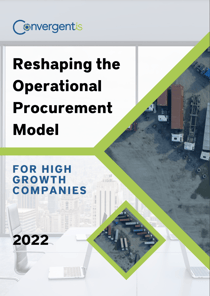Regardless of company size, number of suppliers, or annual spend, investing in new procurement technology comes with a price tag. Although they come with less sticker shock than the million-dollar, year-long implementations typically associated with enterprise solutions, even bridging solutions will often require justification from the Chief Financial Officer (CFO) so they can determine how this proposed technology can be paid for, and whether it will deliver a satisfactory return on investment. As a result, teams are looking into more flexible ways to finance their technology investments, including discussions regarding variations of Capital Expenditure (CapEx) and Operational Expenditure (OpEx) models.
For your team, this calls into question what each pricing model looks like in the procurement space and how these principles can be applied to your next major investment.
CapEx vs. OpEx
Traditionally, Capital Expenditures (CapEx) refer to the money that an organization spends upfront for a building or equipment. These purchases are typically classified as being one-time purchases that can benefit an organization for more than a year. For perspective, some examples may include a server in the IT space or an end-to-end vendor management platform for procurement.
In contrast, an Operating Expense (OpEx) refers to the pay-as-you-go items. Unlike Capital Expenditures, these items appear on your team's profit and loss statement and are immediately deducted from a business' income.
Although terminology around CapEx and OpEx aren't new, their application is slightly different in the procurement context today. With the introduction of the cloud and associated hosting capabilities, the OpEx model can be used to obtain major IT services in a manner that is more attainable than ever before. Consider that the once million-dollar upfront cost may now be broken up into recurring monthly fees.
Weighing the Advantages
To provide further insight into these two types of expenditures, we consider some of the advantages and disadvantages of each in further detail below.
LEAVING MORE CASH ON THE TABLE
Structurally, capital purchases require a payment to be made up-front. Therefore, more cash is tied up in a single purchase. OpEx items, by comparison, allow teams the luxury of paying as they go, meaning that fewer budget dollars are "tied up" and, therefore, more funds can be allocated towards revenue-generating activities.
TAX IMPLICATIONS
CapEx is depreciated over the span of a couple of years. In contrast, Operating Expenditures are fully tax-deductible in the year that they are incurred. While some teams recognize this as an advantage, it is worth noting that other companies looking to increase earnings may prefer the CapEx model since it will amount to a higher value of assets on their balance sheet, resulting in an impact on net income that looks favourable to the company's investors. Naturally, if this value is favourable to investors, the resulting implication may be an eventual increase in company valuation and stock price.
APPROVAL STRUCTURE
In addition to taxes, consider that CapEx and OpEx are accounted for under different budgets and therefore are subjected to different approval processes. On the one hand, major capital items often require approvals through several levels of management (some of which may include the C-Suite). Consequently, teams may find that the process is slowed down significantly.
Comparatively, OpEx items are often lower in cost; therefore, approving them is an easier process. Often only requiring a subset of the same approvals if it fits into a given budget.
VIEW INTO THE FUTURE
When a high cost is required up front, teams are required to execute a certain amount of forecasting. Consider that if the team plans to use the technology for a 5-year span, without upgrading or replacing it until the end of that period, they need some level of confidence that this solution will suffice until that date. Unfortunately, the market is changing at a more accelerated pace than ever before, meaning it is harder to make these forecasts and, more likely, to "overbuy."
Although some teams can make these decisions with accuracy, others don't know what kind of capabilities they will need two, three or four years out. Especially for those businesses considered "high growth," the ability to purchase additional capabilities as they need them is crucial to ensuring teams can be as agile as possible. Moreover, some industries are impacted more closely by seasonal cycles than others. OpEx further provides support for these industries by allowing teams to "size up" only for these times of the year.
SHIFTING OPERATIONS TO AN EXTERNAL PARTY
When undergoing a major IT investment in a CapEx environment, the purchasing organization takes on full responsibility for the technology's capabilities, which may include backups, operating system upgrades, and repairs, which may be costly if adequate support doesn't exist internally.
By hosting these same offerings in an OpEx environment, teams often receive support from the provider with an operating cost baked into monthly fees.
PUTTING CONCEPT INTO APPLICATION
So, what will the decision be? CapEx or OpEx? The answer is neither. Selecting between the two models is not a one-or-the-other situation. Instead, each business must determine which areas make more sense to be financed under each model, carefully weighing the trade-offs listed above.
To kick-start this decision, businesses are encouraged to start by analyzing which upcoming projects can be moved into the cloud, considering factors such as the total cost of ownership. By taking this step, many organizations, especially those with a mature IT strategy or those undergoing significant growth, have found a hybrid approach is most effective in delivering the best of both alternatives.
In support of teams who are looking at these two models for financing their new procurement solutions, our team at ConvergentIS provides our own procurement suite with a model that ensures no major upfront costs are required to start seeing ROI on your efforts.
To learn more, we encourage you to download the white paper below.


